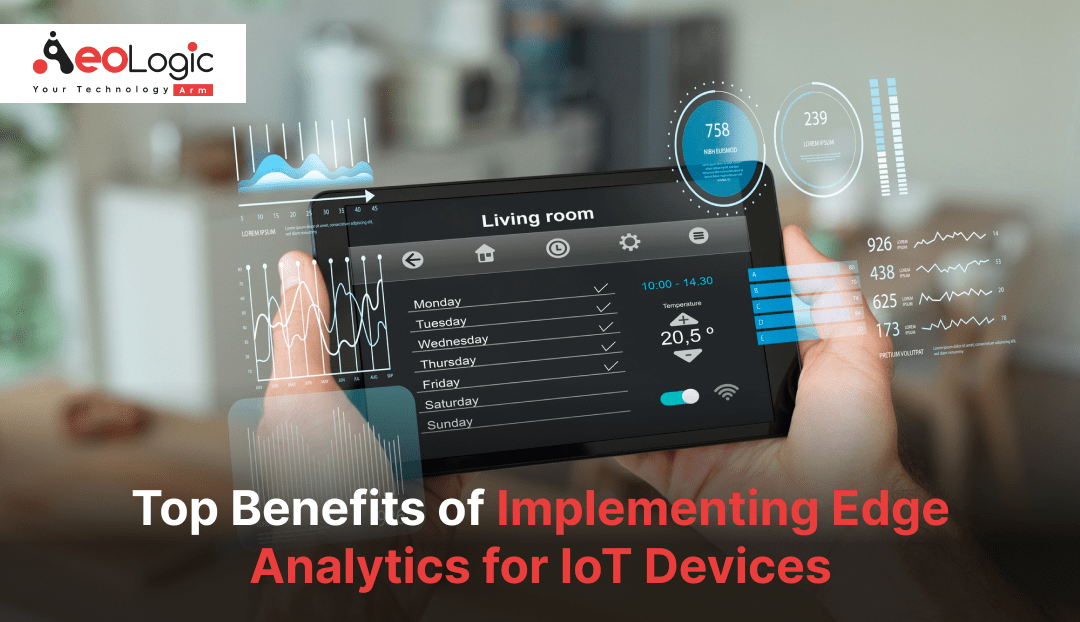Edge Analytics for IoT devices is an innovative approach that focuses on processing data at or near the source where it is generated, rather than transmitting it to a centralized cloud or on-premise server for analysis. Essentially, it involves analyzing data directly on the sensor or device itself. This method capitalizes on the improvements in internet and web connectivity to handle data processing locally, which addresses the growing need for rapid response times and immediate insights in IoT (Internet of Things) environments.
Also read: The Benefits of Edge Computing for Businesses
Understanding The Benefits Of Edge Analytics For IoT Devices
The core principle of Edge Analytics for IoT devices is to decentralize data processing. Instead of sending all data to a central system, it handles the bulk of the analysis on-site, only transmitting the most crucial information back to a central server. This shift is driven by the need for speed and efficiency in processing the vast amounts of data generated by IoT devices. The benefits of Edge Analytics for IoT devices are particularly significant in various industries, including retail, manufacturing, energy, smart cities, transportation, and logistics. These sectors deploy Edge Analytics to gain real-time insights, improve operational efficiency, and respond swiftly to emerging issues.
Importance of Edge Analytics
Time Efficiency
Traditional centralized systems require raw data to be transmitted from internet-connected devices to a central location for processing. This process can be slow and inefficient, as all data, regardless of its relevance or accuracy, must be processed and analyzed. Edge Analytics for IoT devices, on the other hand, filters out unnecessary or irrelevant information at the source. By analyzing data locally, only the most pertinent data is sent to the central system, which reduces both processing and uploading times. This efficiency results in faster decision-making and a more streamlined analytical process.
Cost Reduction
Implementing Edge Analytics can significantly lower costs associated with data storage and management. By reducing the volume of data that needs to be transmitted and processed centrally, organizations can cut down on bandwidth usage and storage requirements. This reduction in data transfer and processing needs also leads to lower operational costs. Many industrial IoT applications generate vast amounts of data that are not always analyzed, resulting in wasted resources. Edge Analytics helps mitigate this issue by ensuring that only useful data is transmitted, providing a cost-effective way to maximize the value derived from data.
Enhanced Privacy
Privacy is a critical concern when dealing with sensitive or confidential information, such as GPS data or video streams. Edge Analytics addresses this concern by preprocessing sensitive data on-site before it is sent to a central server. This preprocessing ensures that only anonymized or privacy-compliant data is transmitted, protecting sensitive information while still enabling advanced cloud-based analysis. This approach maintains data privacy without sacrificing the benefits of sophisticated data processing.
Reduced Data Analysis Latency
Analyzing data at the edge allows for immediate action, particularly in scenarios where equipment or systems may be malfunctioning. Instead of waiting for data to travel to a central analytics environment, edge processing enables real-time analysis and response. For example, if a piece of machinery in a manufacturing plant shows signs of failure, edge analytics can quickly interpret the data and trigger a response, such as shutting down the equipment to prevent further damage. This rapid response capability minimizes downtime and enhances operational efficiency.
Connectivity Reliability
Edge Analytics is beneficial in scenarios where network connectivity is unreliable or intermittent. By processing data locally, edge solutions ensure that applications continue to function even if there are connectivity issues. This capability is particularly valuable in remote locations or areas with limited network access. Additionally, edge analytics can help reduce the costs associated with data transmission by minimizing the need for constant connectivity to central systems.
Bandwidth Efficiency
One of the key advantages of Edge Analytics is its ability to reduce bandwidth usage. By handling data processing locally and only transmitting essential information, organizations can alleviate the burden on backend servers and optimize network traffic. This approach not only improves overall system performance but also reduces the need for expensive data transmission and storage solutions.
Benefits of Edge Analytics
The rise of IoT solutions has led to the generation of massive amounts of data from various sources, which can be challenging to manage. Edge Analytics offers several benefits that help organizations handle this data effectively:
- Decreased Latency: By analyzing data at the edge, organizations can make quicker decisions. For instance, if an IoT component experiences a failure, edge analytics can immediately interpret the data and take corrective actions, reducing or eliminating equipment downtime.
- Simplified Management: Edge Analytics algorithms applied to sensors and devices simplify data management and analysis. As the number of connected devices and the volume of data grow, edge analytics systems can scale effectively, ensuring efficient data processing and analysis.
- Improved Scalability: Edge Analytics allows systems to scale more easily, regardless of the amount of data generated. The decentralized approach to data processing enables organizations to handle growing data volumes without compromising performance.
Latest Use Cases of Edge Analytics
Recent developments in Edge Analytics have led to a variety of innovative use cases across different industries:
Retail Customer Behavior Analysis
Retailers are leveraging Edge Analytics to gather data from various sensors, such as parking lot sensors, shopping cart tags, and CCTV cameras. By applying analytics to this data, retailers can gain insights into customer behavior and preferences, enabling them to offer personalized shopping experiences and targeted marketing strategies. This data-driven approach helps retailers enhance customer satisfaction and drive sales.
Remote Monitoring and Maintenance
In industries like energy and manufacturing, Edge Analytics is used for remote monitoring and maintenance of equipment. Real-time data analysis allows organizations to detect equipment failures or maintenance needs quickly. This proactive approach helps prevent costly downtime and ensures that issues are addressed before they escalate.
Smart Surveillance
Another benefits of Edge Analytics for IoT enhances security by providing real-time intruder detection and monitoring. Security cameras equipped with edge analytics capabilities can analyze raw images on-site to identify and track suspicious activities. This approach improves response times and enhances overall security measures.
Also read: The Role of Edge Computing in IoT Applications
Conclusion
The benefits of Edge Analytics for IoT represents a significant advancement in data processing and analysis, offering numerous benefits across various industries. By decentralizing data processing and focusing on local analysis, organizations can achieve faster decision-making, reduce costs, and enhance privacy. The ability to handle data efficiently, even in the face of connectivity issues or large volumes of data, makes Edge Analytics a valuable tool in the modern IoT landscape. As more industries adopt this technology, the potential for improved operational efficiency and business outcomes continues to grow.







